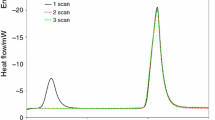Abstract
DSC method was used to study thermal stability of nitrocompounds. It was assumed the model to estimate stability of solid phase in which perfect solid phase is totally stable and amorphous-liquid domains connected with impurities decompose according to the kinetic model determined for the liquid phase above the melting point. The influence of sample purity on relative stability, which is k l/k s — ratio of decomposition rate constants in liquid and solid phase, at temperature 20 K below the melting point was predicted. The increase of liquid domains in solid phase causes decrease of k l/k s ratio (relative stability) at chosen temperature.
Similar content being viewed by others
References
W. P. C. de Klerk, C. Popescu, A. E. D. M. van der Heijden, J. Therm. Anal. Cal., 72 (2003) 955.
G. F. M. Pinheiro, V. L. Lourenco and K. Iha, J. Therm. Anal. Cal., 67 (2002) 445.
C. E. H. Bawn, The decomposition of organic solids (Chapter 10). In: Garner W. E. (Ed.) Chemistry of Solid State, Butterworths, London 1955.
G. Widmann and O. Scherrer, J. Thermal Anal., 37 (1991) 1957.
A. Książczak and T. Książczak, J. Thermal Anal., 43 (1995) 79.
A. Książczak and T. Książczak, Thermochim. Acta, 275 (1996) 27.
F. I. Dubovizky and B. L. Korsunsky, Uspehy himii, 50 (1981) 1828.
F. I. Dubovizky and B. L. Korsunsky, Uspehy himii, 50 (1984) 1928.
S. Zeman, Thermochim. Acta, 202 (1992) 191.
A. J. B. Robertson, Trans. Faraday Soc., 45 (1949) 85.
J. L. Janney and R. N. Rogers, Therm. Anal. Proc. Int. Conf. 7th, Part 2, 1426; US Govt. Rep. (1982) DE 820 12 149.
Y. Oyumi, Propellants, Explos., Pyrotech., 13 (1988) 41.
R. N. Rogers and L. C. Smith, Thermochim. Acta, 1 (1970) 1.
K. K. Andreev, Termicheskoye razlozheniye i goreniye vzryvchatykh veschestv, Izdat. Nauka, Moscow 1966.
Yu.Ya. Maksimov, Tr. Mosk. Khim.-Tekhnol. Inst. Mendeleeva, 53 (1967) 73.
Yu. M. Burov and G. M. Nazin, Khim. Fizika, 3 (1984) 1126.
Author information
Authors and Affiliations
Corresponding author
Rights and permissions
About this article
Cite this article
Książczak, A., Książczak, T. & Zielenkiewicz, T. Influence of purity on the thermal stability of solid organic compounds. Journal of Thermal Analysis and Calorimetry 77, 233–242 (2004). https://doi.org/10.1023/B:JTAN.0000033208.42367.97
Issue Date:
DOI: https://doi.org/10.1023/B:JTAN.0000033208.42367.97




